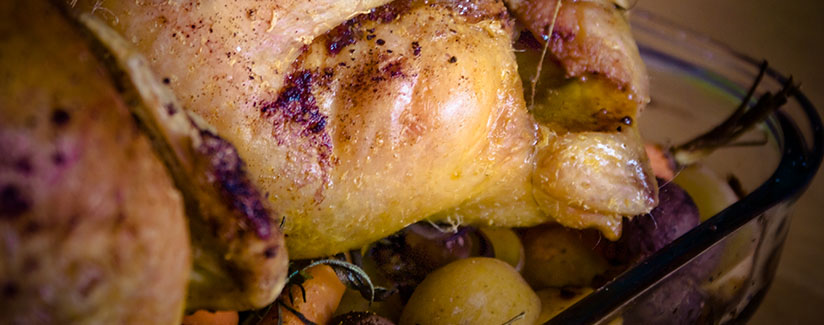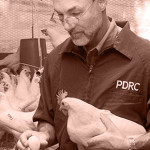
Are There Antibiotics in Chicken Meat? Part 2
Do you buy meat that is labeled “raised without antibiotics”? Is antibiotic resistance a growing problem when it comes to poultry meat? Should we be worried about antibiotics being fed to chickens?
To understand antibiotic use in chickens a bit more, we reached out to Charles L. Hofacre, DVM, MAM, PhD, Professor and Director of Clinical Services, Poultry Diagnostic and Research Center, College of Veterinary Medicine at the University of Georgia; and Ken Macklin, PhD, Associate Professor and Extension Specialist Poultry Health, Environmental Issues and Biosecurity, Department of Poultry Science, Auburn University.
Some antibiotics are classified as for human use. Why are they being fed to poultry if they’re so important to humans?
Dr. Charles L. Hofacre:
I think what the human medical community is finally recognizing is that a lot of hospital-acquired infections don’t have anything to do with food animals. They have to do with our own usage of antibiotics in the human community, not in animals.
Dr. Ken Macklin:
It goes back to historical precedence. They’re available for human and poultry use, and they’ve always been available for both human and poultry use. Yes, there are some human-classified antibiotics being used, but generally only for therapeutic cases.
Why do we treat poultry in mass quantities, and why do we have to treat them all the time, not just when they’re sick?
Dr. Charles L. Hofacre:
There are two different types of medicine. There’s population medicine, and there’s individual medicine. In humans, for example, there is individual medicine where if you have an infection, the doctor will prescribe an antibiotic just for you. With population medicine, for example, if one individual comes down with a disease that is highly communicable, it’s quite possible that the medical community will treat everyone in the population as preventive measures. In poultry, we raise anywhere from 25,000-35,000 chickens in one chicken house. They’re raised on the floor, and they interact with each other, and walk around and get food and water whenever they want, and if a disease gets introduced into that house, the birds could spread it to each other, so we would treat the individual chicken that’s sick, but we would also treat those who are susceptible to the disease, which is why we would treat the whole house with an antibiotic.
Dr. Ken Macklin:
The typical chicken house has at least 20,000 chickens. It would be too challenging to give antibiotics to one certain chicken. For example, the feed mill may produce feed for 120 chicken farms. Two or three farms have chickens with intestinal illness caused by Clostridium perfringens. It’s difficult for the feed mill to make feed just for those two or three specific farms. And often times they do, but most of the time when they’re making feed, they’re making feed for millions of chickens. It’s the make-up of the industry. It’s too large and too costly to make feed just for one or two farms.
Will feeding my children chicken that has been raised with antibiotics increase their chances of having an illness that is antibiotic-resistant?
Dr. Charles L. Hofacre:
As far as we know there is no risk. If the FDA knew of any risk, they would have the ability to immediately withdraw from the market any product considered an imminent human health hazard, and wouldn’t hesitate to do that.
Dr. Ken Macklin:
No. As long as you’re handling the chicken and cooking it properly, there should be no bacteria in the meat that they’re consuming. Antibiotic-resistant bacteria are in the environment naturally. Antibiotics are produced naturally by other bacteria and fungi to combat each other. Is there a chance of getting sick from an antibiotic-resistant bacteria? The answer is yes. However, I would say as long as the meat is properly handled the risk is non-existent.
Are the antibiotics making chickens bigger? Are antibiotics the same as hormones?
Dr. Charles L. Hofacre:
Antibiotics are not hormones. Hormones are natural compounds that are synthesized in all animals. Those compounds are banned for use in poultry and have been for more than 50 years. Antibiotics are compounds that are produced by bacteria or fungi, so because the fungi and the bacteria have to compete with each other, they fight off their neighbor fungi or bacteria to kill it. Antibiotics have been around for a long time. They’re natural compounds that we use to fight off those secondary bacterial diseases like clostridium. Yes, they make chickens grow faster because a sick animal doesn’t grow as well as a healthy animal. Antibiotics are used to keep them healthy. Yes, chickens today are bigger than the chickens of yesterday, and that’s due to genetic selection. Farmers have selected chickens for breeding that grow big and grow fast to be the mother and father for the next generation. That has been going on since the 1930s. That’s why chickens have gotten bigger – by selective breeding of birds.
Dr. Ken Macklin:
No, antibiotics are not hormones. Hormones for use in poultry have been outlawed since the 1950s. If the chickens are sick and you’re making them healthy, they’re going to grow better. If you have chickens that aren’t sick and they are given antibiotics, they’re going to grow at the same rate.
Do poultry companies have to use antibiotics in raising their chickens? Could they get by without using them? What would happen if we didn’t use them?
Dr. Charles L. Hofacre:
If we were not able to use any antibiotics for treatment or prevention of disease, then that would result in an extreme welfare issue for the chickens, or any animal in general. Any time an animal got sick, then you’d just have to let them get sick and die instead of treat them. When it comes to the prevention of disease, if we were unable to give antibiotics in the feed, we would see significant increase in intestinal disease. If we didn’t have antibiotics for treatment, they would just get sick and suffer.
Looking for more information?
Are There Antibiotics in Chicken Meat? Part III: Antibiotics Regulation
“Roasted Chicken” by Clemens v Vogelsang is licensed under CC BY.



























